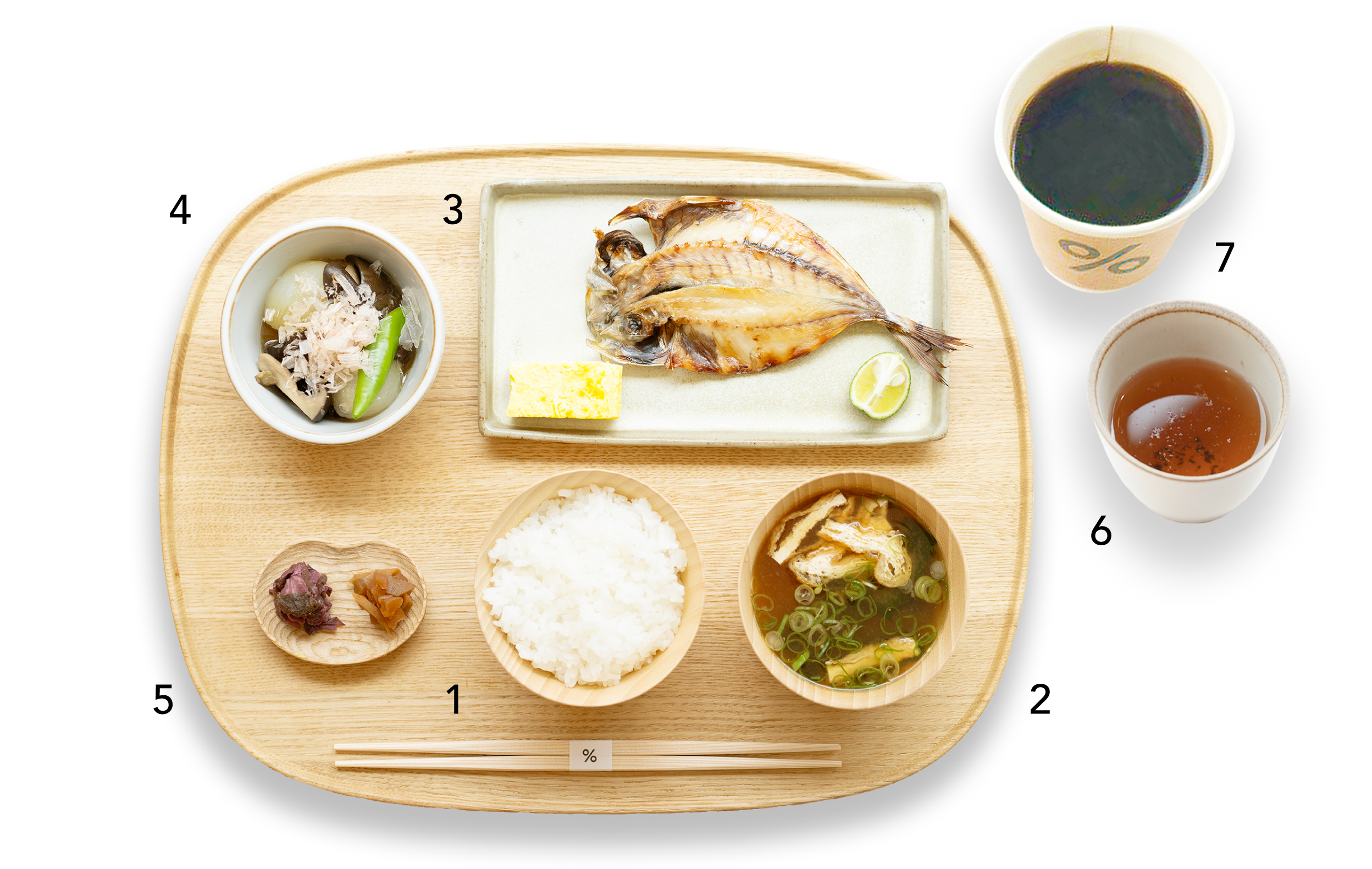
1. Rice : Blend Rice
・ A blend of rice cultivated naturally using no pesticides, no fertilizers, or organic fertilizers in the best combination.
・ The rice is polished on the morning of the day it is served and cooked in an earthenware pot timed to match the customer’s arrival.
2. Miso Soup : Miso soup with green onions, wakame seaweed, and fried tofu.
・ After the customer arrives, the miso is dissolved in the broth and served immediately in a bowl.
・ The broth is made with the finest 3-year-aged Rishiri kelp from Hokkaido, dried bonito from Kagoshima, mackerel flakes, and dried sardine flakes (occasionally using high-quality natural fish bones if available).
・ Miso includes 3-year-aged brown rice miso, rice miso, and white miso from Nagano Prefecture.
・ Kujo onions from Kyoto (organically grown).
・ Wakame seaweed from Miyagi Prefecture.
・ Fried tofu from Kyoto.
3. Main Dish : Homemade dried mackerel(Setsuki) fish from Hagi.
・ This refers to the horse mackerel caught near Hagi. The underwater rocky areas are called “se,” and the fish is named “se-tsuki aji” because it resides in these areas. Unlike migratory horse mackerel (oki aji), se-tsuki aji feed abundantly on high-quality bait found in these regions, resulting in a fatty and plump flesh. The fish is opened from the back, lightly salted, dried overnight, and then grilled over Kishu Bincho charcoal.
・ Served with Sudachi citrus.
*If the catch is not at the best quality ,there is a possibility of using mackerel from another source of area.
: Dashi Maki Tamago
・ Free-range eggs from Nishimura Poultry Farm in Shiga Prefecture.
・ The dashi base consists of the highest quality three-year-aged kelp from Rishiri, Hokkaido, round herring flakes, mackerel flakes, and bonito flakes.
4. Side Dish : Simmered miniature onions (pekorosu), Kamo eggplant, Manganji peppers, and Daikoku hon-shimeji mushrooms, topped with bonito flakes.
・ Bonito flakes shaved after the customer arrives (Katsuo, high-quality whole dried bonito).
・ Miniature onions (pekorosu) cultivated naturally from Sumoto, Awaji Island.
・ Kamo eggplant.
・ Manganji peppers.
・ Daikoku hon-shimeji mushrooms.
5. Pickles
・ Shibazuke pickles from Ohara, Kyoto (naturally grown).
・ Boiled and pickled daikon radish and ginger from Kyoto.
6. Japanese Tea
・ Hojicha Chai: Sprinkled with red sansho pepper from Kyoto for a spicy aroma.
7. % Coffee
・ Choose your favorite espresso drink after the meal. Takeout is also available.
1. ご飯:ブレンド米
・ブレンド米・無農薬、無肥料又は有機肥料で栽培した自然栽培のお米をベストな配合でブレンドしています。
・提供する日の朝に精米をしたお米を、お客様のご来店時間に合わせて土鍋で炊き上げています。
2. お味噌汁:青葱とワカメとお揚げの味噌汁
・お客様がご来店してから出汁に味噌を溶いて、椀に汁をそそぎ、直ぐに提供します。
・北海道産の最高級の蔵囲い3年利尻昆布と鹿児島産の鮪枯節と鯖節と宗田節で引いたお出し。(良質な天然魚の荒骨があれば出汁材料として使用する事もあります。)
・長野県産の3年熟成の玄米味噌と米味噌と白味噌。
・京都産の九条葱。(有機栽培)
・宮城産のワカメ。
・京都産お揚げ。
3. 主菜:萩の瀬つきアジの自家製干物
・萩の近海でとれるマアジのことです。海底の岩礁を「瀬」と呼び、その「瀬」に居着くことから「瀬つきあじ」と命名されました。瀬つきあじは回遊性のあじ(沖あじ)と違い、良質なエサが豊富にある瀬に居ついているためエサをたっぷり食べ、脂がのってふっくらした身質が特徴です。背開きにして、薄く塩をふり、一晩乾燥させてから、紀州備長炭の炭火で焼いています。
・新物のすだちを添えて。
*不漁の時は別の産地のアジを使用する場合もございます。
:出汁巻き卵
・淡路島洲本の平飼い卵。
・北海道産の最高級の蔵囲い3年利尻昆布と鯖節、宗田節でとったお出汁。
4. 副菜:極小サイズの玉ねぎ(ペコロス)と賀茂茄子と万願寺唐辛子と大黒本しめじの煮物、鰹節をトッピング
・お客様がご来店してから削る鰹節。(南方一本本枯節オモ)
・淡路島洲本の自然栽培の極小サイズの玉ねぎ (ペコロス)
・賀茂茄子。
・万願寺唐辛子。
・大黒本しめじ。
5. お漬物
・京都大原産の志ば漬。(自然栽培)
・京都産の大根と生姜の煮切り漬け。
6. 日本茶
・ほうじ茶チャイ:京都産の赤山椒を最後に振ってスパイシーな香りを出しています。
7. % コーヒー
・食後にお好きなエスプレッソドリンクをお選びください。テイクアウトも可能です。
